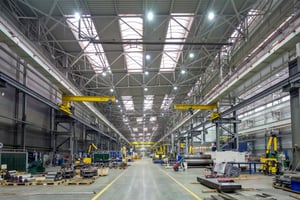
Remember in “Back to the Future” when they're in the mall parking lot and Doc is testing his DeLorean? As the contraption speeds up to 88 miles per hour before disappearing into the void, Doc isn't just ripping a hole in space and time, but demonstrating the value of an accurate digital display.
As Doc operates the vehicle with his remote control — with Marty watching wide-eyed and poor Einstein the dog sitting in driver's seat — the rising tension centers on the controller's LED readout as the DeLorean's speed creeps up toward that transcendent threshold.
There's a reason Doc didn't rely on an analog display as the exotic sports car hurdles toward him and young Marty. In the process of making the most important scientific breakthrough in the history of human civilization, Doc knows the value of precision.
The same goes for people in charge of complex manufacturing facilities. But precision is just one reason you might want to opt for digital clocks for your plant. Here are three reasons it makes sense to go digital in a factory setting.
1. Enhanced Readability
Digital clocks are especially well-suited for facilities with large rooms, such as manufacturing floors, where people might otherwise have to squint every time they look at the time.
Manufacturing requires exactitude, sometimes with personnel making shift changes 24 hours a day. As they try to stay in step with the manufacturing process, those employees often have dangerous jobs that don't afford much time for, well, telling the time.
Digital clocks provide relief thanks to their visibility — a 4-inch digital clock can be read from over 250 feet away.
2. Easier to Stay on Schedule
When DMR Electronics, a manufacturer of industrial electronic components and wiring harnesses, moved into a new 60,000 square-foot facility, they made sure to include digital clocks when setting up a synchronized time system.
The company was having problems with inaccurate clocks that made it difficult to tell if employees were clocking in on time. The start times for meetings were even a subject of debate. Installing a synchronized clock system helped solve those issues, and putting digital clocks on the wall ensured that employees could easily tell the time, which they could now be sure was correct.
3. Greater Functionality
Aside from being easy to see, digital clocks make life easier by offering countdown and count-up functions. A digital clock might be set to countdown the time until the beginning or end of a shift, or to mark the progress of time-sensitive operations that require intricate precision.
These features can be paired with bells and buzzers for added benefit. And speaking of precision, digital clocks often will display seconds in addition to minutes and hours. They are flexible, too — capable of switching between 12- and 24-hour formats.
For those looking for functionality beyond digital clocks, American Time offers EverAlert, a digital display system that combines synchronized timekeeping, emergency notifications and digital messaging that can help make sure everyone in your facility is well-informed and on time.

